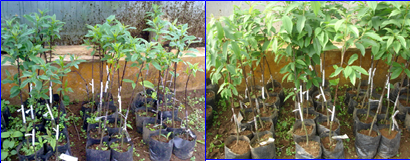Authors: R. K. Patel*, N.A. Deshmukh and Bidyut C. Deka
Division of Horticulture
ICAR Research Complex for NEH Region, Umiam-793 103 (Meghalaya)
*ICAR-NRC on Litchi, Muzaffarpur-842002, Bihar
Sohiong (Prunus nepalensis) belongs to family Rosaceae is an important indigenous underutilized fruit of the region. It has great potential in the region due to its fruit quality, unique colour and flavour. It is found in East Khasi Hills, West Khasi hills and Jaintia hills district of Meghalaya and some parts of Manipur state. Fruits are eaten as fresh, while fruit juice and pulp are used for preparation of various processed products like squash, jam, RTS and wine. Sohiong plants are propagated through seeds by the farmers from long time. Propagation from seeds results not only variation in fruit quality but also have the long gestation period (> 8 years) as well as huge canopy size. It is well proven that the vegetative propagation in any plants results in true to type crop with short juvenile phase and canopy size. Owing to long gestation period and high canopy size, a novel plant multiplication technique through grafting (wedge and tongue) in sohiong has been standardized at ICAR Research Complex for NEH Region, Umiam (Meghalaya) for raising the quality planting material.

Raising of rootstock
The well ripens fully blackish/purplish coloured fruits should be collected during September for seed extraction purpose. The seed should be extracted from fruit by removing the pulp through soaking of seed in water for about 3-4 days for fermentation of pulp adhering on seed. After that seeds should be washed in water and dried under shade for 24 hours. The dried seeds should be kept for 3-4 weeks in a pot under alternate layer of moist sand for stratification. Seed coat starts rupture at 3 weeks of stratification and then these ruptured seed should be sown in poly bag containing equal amount of soil, sand and FYM mixture about 5 cm deep during October. Seeds start germination about 30-45days after sowing.
Selection of scion
Five to six months old shoot should be selected as scion material from healthy mother plants of sohiong. The scion shoot of pencil thickness with 3 to 4 internodes of 25-30 cm long should be used for grafting.
Grafting technique
One year old rootstock of pencil thickness (0.5-1.0 cm) should be used for grafting purpose. Best time of grafting is IInd week of October, when stock and scion are in dormant condition. Stock and scion of equal diameter is selected. For tongue grafting, a smooth slanting cut of 4 -5 cm long is made on the rootstock at about 15-20 cm above the ground level and another downward cut is given starting approximately 2/3rd from the top of the slanting cut and about 2 cm in length. This formed a tongue like structure on the stock. Similar cut is also made on the lower side of the scion exactly matching the cut given on the rootstock, whereas for wedge grafting, rootstock is headed back about 15 â€"20 cm above the ground level and then, the beheaded rootstock is split to about 3.5 to 4 cm deep through the center of stem with grafting knife. A wedge shaped cut, slanting from both the sides (3-4cm long) is made on the lower side of the scion shoot. The scion stick then inserted into the split of the stock and pressed properly. The union is tied with the 150 gauge polythene strip. The union completed within 30-45 days of grafting and after that polythene strip should be removed to avoid girdling. The graft success of > 80% can be achieved through both the methods.
References
1. Patel, R.K., Deshmukh, N.A., Nath, A., Deka, B.C. and Patel, R.S. (2013). Sohiong (Prunus nepalensis) and Sohshang (Elaeagnus latifolia Linn.): Potential fruits of Meghalaya need commercialization. Developing the potential of Underutilized Horticultural crops of hill regions edited by N. Prakash et al., Today & Tomorrow’s Printers and Publishers, New Delhi. pp 456-467.
2. Patel, R.K., Singh Akath, Deka, B.C. and Ngachan, S. V. (2008). Handbook of fruit production. Published by the Director, ICAR Research Complex for NEH Region, Umiam-Meghalaya.
About Author / Additional Info:
Scientist fruit science working on organic farming of litchi, plant propagation and nursery management of fruits.